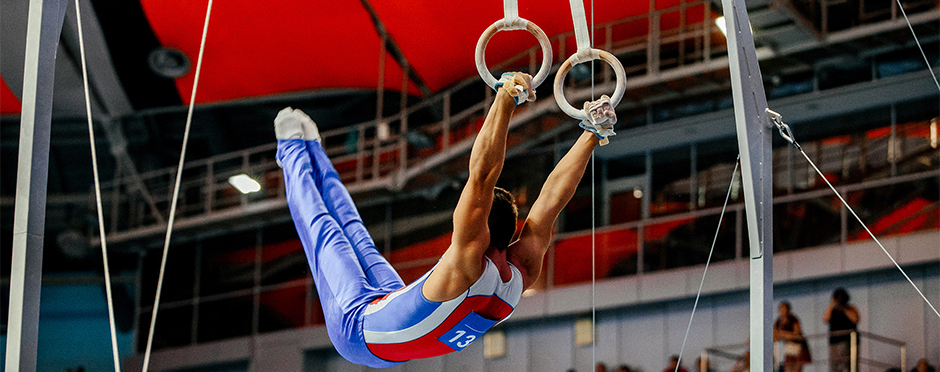
Top Injuries in Male Gymnasts
Leave a CommentMale and female gymnasts compete in similar but different events. Men’s gymnastics events place different demands on the body, especially the upper body, for events such as rings, high bar, parallel bars, and pommel horse. Therefore, the top injuries for male and female gymnasts may be different. Current research has shown that adolescent male gymnasts tend to have more lower-body injuries, whereas elite male gymnasts have more upper-body injuries. In general, male gymnasts tend to have more upper body injuries than female gymnasts.
Here are five examples of common injuries that can occur in male gymnasts:
1. Shoulder Instability
Male gymnasts put a lot of stress on their upper extremities and shoulders. When performing tumbling skills, research has shown that a gymnast can experience up to 16 times their body weight through their arms3. The shoulder joint relies on strong muscles, ligaments, and the labrum to provide stability for the wide range of motion that travels through the shoulder. Weakness in the shoulder muscles can contribute to laxity in the shoulder joint, which can cause pain and a feeling of instability when hanging or weight-bearing on that arm.
Shoulder instability can occur when any structures are injured or not working properly to provide support. Shoulder instability symptoms include:
- The shoulder giving out
- A feeling that the shoulder is loose
- History of shoulder subluxations or dislocations and pain.
Treatment for shoulder instability usually begins with physical therapy to address weaknesses throughout the shoulder and a gradual return to all sports skills. If symptoms persist, there are surgical options to treat shoulder instability also.
2. Wrist Sprains
A wrist sprain occurs when there is an excessive stretch on the ligaments that connect the forearm bones to the bones in the wrist and hand. In gymnasts, this can occur because of a fall onto an outstretched arm, a large rotation of the wrist or an overstretch of the wrist in any direction. Wrist sprains are initially treated with the RICE (rest, ice, compression, and elevation) method. Wrist braces can help protect the wrist after an injury occurs. Wearing a wrist brace can support the wrist to rest and recover.
After a wrist sprain, gymnasts will be unable to bear weight on their hands, which means no tumbling or hanging from bars. Physical therapy can be beneficial after a wrist sprain to help recover and get back to all gymnastic activities.
3. Ankle Sprains
An ankle sprain occurs when the ankle is overstretched or twisted. A severe sprain can include a tear of the ligament in the ankle. An ankle sprain can occur with landing wrong after a jump, rolling the ankle while running, twisting the ankle during a turn, or falling.
Ankle sprains can be quite painful. Swelling is usually present and possibly bruising over the foot and ankle. The ankle will be stiff, and the athlete may be unable to place their full weight on that foot initially. Treatment for ankle sprains may include a boot or ankle brace. Physical therapy after an ankle sprain focuses on flexibility in the ankle, strength, and balance to get back to running, jumping, and tumbling skills for gymnasts.
4. Achilles Tendonitis
Achilles tendonitis is usually pain at the tendon’s insertion into the heel bone or in the middle portion of the tendon. Gymnasts are at increased risk of Achilles tendonitis due to the nature of their sport: repetition of skills, sudden starts and stops, and repetitive jumping. Over time, it is thought that Achilles tendonitis leads to changes in the normal fiber arrangement of the tendon. Due to these changes, thickening can occur, and the area can become less flexible. This, in turn, leads to weakness of the tissue, leading to an increased risk of Achilles tendon rupture.
Symptoms of Achilles tendonitis can include swelling, tenderness, and pain with walking at the back of the heel. Treatment usually includes rest, stretching, and physical therapy to address tight muscles and areas of weakness.
5. Rotator Cuff Injuries/Shoulder Impingement
Rotator cuff injuries usually occur gradually in gymnasts due to repetitive overhead movements, muscle weakness, or previous injuries. The rotator cuff has to work hard to support the shoulder, and it can become tired over time. This can lead to inflammation and weakness as well as pain. The symptoms of shoulder impingement include pain in the mid-range of shoulder movement, weakness and pain with reaching behind the back or reaching overhead, pain at night when sleeping on that shoulder, and the loss of strength.
Physical therapy is usually the first treatment for shoulder impingement. Overhead activities are put on hold, including no tumbling and no hanging for gymnasts. Therapy will focus on reteaching the muscles to support the humerus in the shoulder joint. Gradual return to all gymnastics skills will occur depending on pain levels and recommendations from your physical therapist.
Athletico has clinicians that specialize in treating gymnasts and their injuries. Request a free assessment at your nearby Athletico clinic to get started. Free assessments are available both in-clinic and virtually through our telehealth platform.
The Athletico blog is an educational resource written by Athletico employees. Athletico bloggers are licensed professionals who abide by the code of ethics outlined by their respective professional associations. The content published in blog posts represents the opinion of the individual author based on their expertise and experience. The content provided in this blog is for informational purposes only, does not constitute medical advice and should not be relied on for making personal health decisions.
References:
1. Ahmad B, LaBella CR, Wolf SF. Boys gymnastics injuries: A 9-year retrospective review. Phys Sportsmed. 2021 May 27:1-5. doi: 10.1080/00913847.2021.1929535. Epub ahead of print. PMID: 33993828.
2. Westermann RW, Giblin M, Vaske A, Grosso K, Wolf BR. Evaluation of Men’s and Women’s Gymnastics Injuries: A 10-Year Observational Study. Sports Health. 2015;7(2):161-165. doi:10.1177/1941738114559705
3. Webb BG, Rettig LA (2008) Gymnastic wrist injuries. Curr Sports Med Rep 7:289–295
